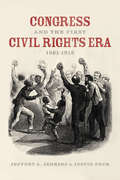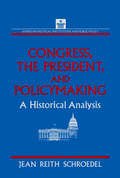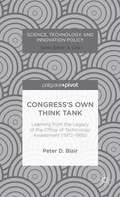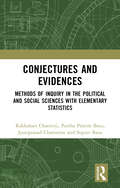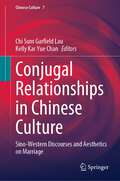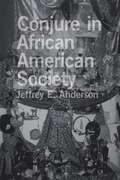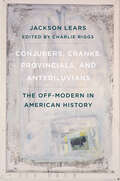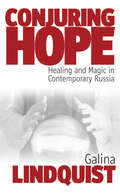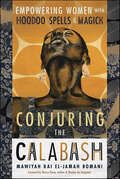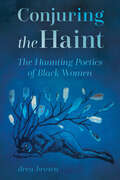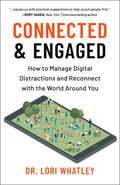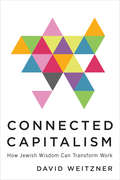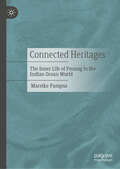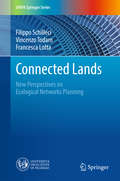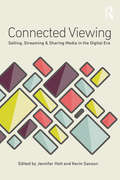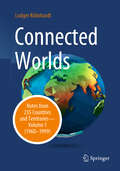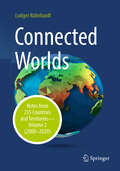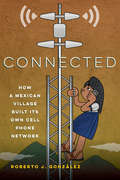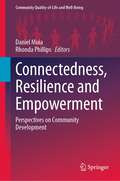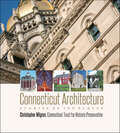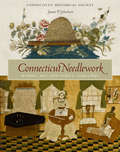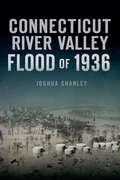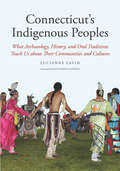- Table View
- List View
Congress and the First Civil Rights Era, 1861-1918
by Jeffery A. Jenkins Justin PeckCivil rights legislation figured prominently in the agenda of Congress during the Civil War and Reconstruction. But as Reconstruction came to an end and discrimination against African Americans in the South became commonplace, civil rights advocates in Congress increasingly shifted to policies desired by white constituents in the North who had grown tired of efforts to legislate equality. In this book, the first of a two-volume set, Jeffery A. Jenkins and Justin Peck explore the rise and fall of civil rights legislation in Congress from 1861 to 1918. The authors examine in detail how the Republican Party slowly withdrew its support for a meaningful civil rights agenda, as well as how Democrats and Republicans worked together to keep civil rights off the legislative agenda at various points. In doing so, Jenkins and Peck show how legal institutions can be used both to liberate and protect oppressed minorities and to assert the power of the white majority against those same minority groups.
Congress and the First Civil Rights Era, 1861-1918
by Jeffery A. Jenkins Justin PeckCivil rights legislation figured prominently in the agenda of Congress during the Civil War and Reconstruction. But as Reconstruction came to an end and discrimination against African Americans in the South became commonplace, civil rights advocates in Congress increasingly shifted to policies desired by white constituents in the North who had grown tired of efforts to legislate equality. In this book, the first of a two-volume set, Jeffery A. Jenkins and Justin Peck explore the rise and fall of civil rights legislation in Congress from 1861 to 1918. The authors examine in detail how the Republican Party slowly withdrew its support for a meaningful civil rights agenda, as well as how Democrats and Republicans worked together to keep civil rights off the legislative agenda at various points. In doing so, Jenkins and Peck show how legal institutions can be used both to liberate and protect oppressed minorities and to assert the power of the white majority against those same minority groups.
Congress, the President and Policymaking: A Historical Analysis
by Jean Reith SchroedelThe underlying theoretical premise of this text is that the separation between the executive and legislative functions has important policy consequences and has influenced legislative outcomes. The study analyzes the pattern of interaction on banking bill introductions over the past 150 years.
Congress’s Own Think Tank: Learning from the Legacy of the Office of Technology Assessment (1973–1995)
by Peter D. BlairCongress' Own Think Tank recaps the OTA experience--it's creation, operation, and circumstances of its closure-- and that of organizations attempting to fill the gap since OTA's closure as well as a number of new forces shaping the current context for science and technology issues facing the Congress.
Conjectures and Evidences: Methods of Inquiry in the Political and Social Sciences with Elementary Statistics
by Rakhahari Chatterji Partha Pratim Basu Jyotiprasad Chatterjee Suprio BasuThis book examines some of the major and most commonly used methods and statistics necessary for social science research. It is meant primarily for the beginners, and hence does not require any prior training in research methodology or statistics. The methods discussed include aggregate data analysis, the method of survey research, experimental and quasi-experimental research designs, participant observation, content analysis, and focus groups study. In a separate chapter the issue of quantitative and qualitative research methods and their uses has been discussed. An attempt has been made to assess these methods especially from the point of view of their adoption and application by social scientists working in the developing economies. Print edition not for sale in South Asia (India, Sri Lanka, Nepal, Bangladesh, Pakistan or Bhutan)
Conjugal Relationships in Chinese Culture: Sino-Western Discourses and Aesthetics on Marriage (Chinese Culture #7)
by Kelly Kar Yue Chan Chi Sum Garfield LauThis book reviews the presentation of conjugal relationships in Chinese culture and their perception in the West. It explores the ways in which the act of marriage is represented/misrepresented in different literary genres, as well as in cultural adaptations. It looks at the gendered characteristics at play that affect conjugal relationships in Chinese societal practices more widely. It also distinguishes between the essential features that give rise to nuptial arrangements from the Chinese perspective, looking at what in which Sino and/or Western mentalities differ in terms of notions of autonomy in marriage. It excavates the extent to which marriage is constituted in forms of transaction between female and male bodies and asks under what circumstances wedding ceremonies constitute archetypal or counter-archetypal notions in pre-modern and modern society. Authors cover a range of fascinating cultural topics, such as posthumous marriage (necrogamy) as an ancient and popular folk culture from the perspective of Confucian ideology, as well as looking at marriage from ancient to present times, duty and rights in conjugal relations, inter-racial and inter-cultural marriage, widowhood in Confucian ideology, issues of legitimacy in marriage and concubinage, the taboos surrounding divorce and re-marriage, and conjugal violence. The book serves to revisit the cultural connections between marriage and various art forms, including literature, film, theatre, and other adaptations. It is a rich intellectual resource for scholars and students researching the historical roots, cultural interpretations, and evolving aspects of marriage as shown in literature, art, and culture.
Conjure in African American Society
by Jeffrey E. AndersonFrom black sorcerers' client-based practices in the antebellum South to the postmodern revival of hoodoo and its tandem spiritual supply stores, the supernatural has long been a key component of the African American experience. What began as a mixture of African, European, and Native American influences within slave communities finds expression today in a multimillion dollar business. In Conjure in African American Society, Jeffrey E. Anderson unfolds a fascinating story as he traces the origins and evolution of conjuring practices across the centuries. Though some may see the study of conjure as a perpetuation of old stereotypes that depict blacks as bound to superstition, the truth, Anderson reveals, is far more complex. Drawing on folklore, fiction and nonfiction, music, art, and interviews, he explores various portrayals of the conjurer -- backward buffoon, rebel against authority, and symbol of racial pride. He also examines the actual work performed by conjurers, including the use of pharmacologically active herbs to treat illness, psychology to ease mental ailments, fear to bring about the death of enemies and acquittals at trials, and advice to encourage clients to succeed on their own. By critically examining the many influences that have shaped conjure over time, Anderson effectively redefines magic as a cultural power, one that has profoundly touched the arts, black Christianity, and American society overall.
Conjurers, Cranks, Provincials, and Antediluvians: The Off-Modern in American History (The\margellos World Republic Of Letters Ser. #4)
by Jackson LearsThe best essays from America’s premier cultural historian Jackson Lears has been hailed as the “dean of American cultural history” and “one of the few pre-eminent historians of our time.” Well known for his elegant, daring scholarship on topics such as antimodernism, advertising, and luck, Lears has also been a critic and essayist whose public-facing writings—published in journals such as the New Republic, The Nation, the London Review of Books, and the New York Review of Books—have explored a variety of subjects and themes, both contemporary and historical, from modern environmentalism to liberal arts education, from the plastics industry to the happiness industry, from Theodore Roosevelt to Seymour Hersh, from Van Wyck Brooks to Anne Applebaum. The essays collected here, written over the course of over forty years, are absorbing reading for anyone interested in American history, culture, or intellectual life and provide models of an engaged critic at work on topics and figures both high and low. Offering compelling lenses on historical subjects while setting contemporary culture in rich historical perspective, the essays bridge the gap between history and social commentary and afford a sweeping view of the changing intellectual scene from 1977 to the present.
Conjuring Hope
by Galina LindquistNotions of magic and healing have been changing over past years and are now understood as reflecting local ideas of power and agency, as well as structures of self, subjectivity and affect. This study focuses on contemporary urban Russia and, through exploring social conditions, conveys the experience of living that makes magic logical. By following people's own interpretations of the work of magic, the author succeeds in unraveling the logic of local practice and local understanding of affliction, commonly used to diagnose the experiences of illness and misfortune.
Conjuring the Calabash: Empowering Women with Hoodoo Spells & Magick
by Kai EL-Jamah Bomani"This book is about Black girl magick, queer girl magick, straight girl magick, trans magick, bisexual magick. It's about giving yourself the power to be fierce...Black women are Hierophants, Magicians, Empresses, and High Priestesses."—Mawiyah Kai El-Jamah Bomani Authentic and unapologetic, this guide to magical spirituality empowers you to take back the power to heal and shine under your own strength. Written by an accomplished Hoodoo practitioner, Conjuring the Calabash features spells, recipes, and rituals that help you rise out of the constrictions around you.Mawiyah Kai El-Jamah Bomani shows you how to bless your calabash (sacred womb) with love and reawaken your fullest potential through folk traditions, personal stories, and her favorite songs and pop stars. An inclusive and intersectional voice in contemporary Hoodoo, Mawiyah will help you become your fiercest self.
Conjuring the Haint: The Haunting Poetics of Black Women (Margaret Walker Alexander Series in African American Studies)
by drea brownWhat does it mean to live as a ghost, to live with ghosts, and how might ghosts lead to a path of healing and reimagining? Through an investigation of the intimate relationship between haunting and grief, Conjuring the Haint: The Haunting Poetics of Black Women posits that for Black women, haunting is both a condition and a strategy in lived experiences and literary productions.Looking at the poetry of Phillis Wheatley, Lucille Clifton, Ntozake Shange, Lyrae Van Clief-Stefanon, and Claudia Rankine, Conjuring the Haint explores primary stereotypes of Black women. They are aligned with unruly incarnations of the haint, probing the eerie similarities between this specter and one-dimensional imaginings of Black womanhood, examining how this haintliness manifests in Black women’s elegies, the poetry of grief. Disrupting a tradition of consolation and poetic succession, Black women’s elegies rework the genre by wrestling with multiple forms of death: physical, social, and spiritual. These elegies aim both to lay to rest and to resurrect. Black women poets are then repositioned as conjurers who, through the spirit work of poetry, reckon with haints as complex figures of despair and repair. Each chapter explores the paradox of haints, as evidence of injury and loss and as a pathway to knowledge articulated by various incarnations—the hag, the banshee, and the vengeful revenant. Chapters place these against pervasive images of Mammy, Jezebel, and Sapphire. Through a pairing and dismantling of these ill-fitting myths, Conjuring the Haint refigures haints as a means of recognition and self-possession, a manifestation of the ancestral and divine.
Connected & Engaged: How to Manage Digital Distractions and Reconnect with the World Around You
by Lori WhatleyDon&’t let digital devices highjack your life—this inspirational guide shows you how to disconnect so you can reconnect with your loved ones and mental well-being.As a clinical psychologist, Dr. Lori Whatley has invested years into helping people manage their digital devices to live fuller, more vibrant lives.This book looks into the damage that disconnection and disengagement can have on our relationships with technology as its root cause. Many relationships suffer from overuse of technology. The result of which creates tension, sadness, and loneliness.Sharing from her one-on-one sessions with patients, Dr. Whatley reveals practical steps that will empower and transform one's relationships and your life.The inspirational message in each chapter will encourage you to: Create strong relational connections with the people closest to you Restore intimacy and person-to-person interaction Reduce the impact of technology on children and families Minimize the stress that comes from your digital devices Engage your world with renewed energy and confidence Find new passion, meaning and purpose Are you ready to connect with the people around you, engage in the world, and create a life that makes you feel alive?
Connected Capitalism: How Jewish Wisdom Can Transform Work
by David WeitznerIn our present state of disconnect and loss, Connected Capitalism offers us a deeper and more satisfying approach to both work and life. What should our post-COVID work world look like? In Connected Capitalism, David Weitzner shows us how to draw from the classic teachings of Judaism in order to positively transform our workplaces and our working lives. He outlines a philosophy that will empower the disenchanted to build a stable future in a world of crony capitalism, global pandemics, racial injustice, and social disconnect. Weitzner, a professor of management who chooses to look beyond management and mindfulness, envisions a workplace based on the ancient Jewish practices of mitzvah, creating a space for meaningful moments with other people, and chavrusa, co-creating and working on endeavors together. Combining these spiritual concepts with the voices of today’s political strategists, business leaders, and artists, Connected Capitalism inspires us to approach our work with curiosity, engage with those who were once strangers, and tap into a hopeful and meaningful future.
Connected Heritages: The Inner Life of Penang in the Indian Ocean World
by Mareike PampusConnected Heritages: The Inner Life of Penang in the Indian Ocean World opens up the interdisciplinary possibilities of transnational and oceanic historical inquiry paired with granular ethnographic research. Departing from conventional land- and nation-centric approaches, the book situates Penang, Malaysia – and particularly its historic core, George Town – within the fluid realm of lateral networks, revealing the profound influence of the sea on the port city&’s political, economic, social and cultural landscape. It does so by integrating ethnographic depth, offering readers an intimate and immersive journey into the lived experiences of George Town&’s diverse communities, notably its two major Peranakan groups, with a broader historical and transnational understanding of the circulations that have shaped the inner life of the port city. Through the careful observation and interpretation of everyday practices, habits and stories, this singular study paints a vivid portrait of the port city&’s complex connections and identities shaped by its maritime connections. In doing so, the book offers an anthropology of the everyday and its utility for developing our understanding of the ways in which people and communities in Penang perceive and interpret their contemporary reality.
Connected Lands: New Perspectives on Ecological Networks Planning (UNIPA Springer Series)
by Filippo Schilleci Vincenzo Todaro Francesca LottaThis book explores and outlines the reference theoretical basis of ecological networks within the international debate, focusing on how protected areas should no longer be considered as the sum of different components but rather as a network. The various European, transnational and national models of ecological networks/connections are analyzed on the basis of a detailed, updated study of relevant documents. The complex picture that emerges shows a wide range of reticular-ecological models within European plans and programs, but also many non-integrated experiences. The book subsequently examines the regulation of ecological networks/connections within planning instruments, explaining the critical points and referring to different ecological network models and specific local realities. Lastly, the book addresses two Italian case studies regarding the different normative and planning frameworks, both at a national and regional level, and demonstrating not only how ecological networks/connections can be structured within plans, but also how these networks/connections represent the core element of territory development and preservation. As such, it provides an essential tool for containing habitat fragmentation, offering a new perspective that integrates theoretical approaches and methods with planning models and the lessons learned from local applications.
Connected Viewing: Selling, Streaming, & Sharing Media in the Digital Age
by Jennifer Holt Kevin SansonAs patterns of media use become more integrated with mobile technologies and multiple screens, a new mode of viewer engagement has emerged in the form of connected viewing, which allows for an array of new relationships between audiences and media texts in the digital space. This exciting new collection brings together twelve original essays that critically engage with the socially-networked, multi-platform, and cloud-based world of today, examining the connected viewing phenomenon across television, film, video games, and social media. The result is a wide-ranging analysis of shifting business models, policy matters, technological infrastructure, new forms of user engagement, and other key trends affecting screen media in the digital era. Connected Viewing contextualizes the dramatic transformations taking place across both media industries and national contexts, and offers students and scholars alike a diverse set of methods and perspectives for studying this critical moment in media culture.
Connected Worlds: Notes from 235 Countries and Territories - Volume 1 (1960-1999)
by Ludger KühnhardtThe notes that Ludger Kühnhardt wrote in 235 countries and territories around the world create a fascinating panorama, reflected in the personal impressions, encounters and experiences of a political scientist and journalist working all over the world. The book reconstructs the connections between Europe's transformations and the emerging global era over six decades from 1960 to the threshold of the post-Corona world of 2020.
Connected Worlds: Notes from 235 Countries and Territories - Volume 2 (2000-2020)
by Ludger KühnhardtThe diary notes that Ludger Kühnhardt took while visiting or staying in 235 countries and territories around the world create a fascinating panorama, reflected in the personal impressions, encounters and experiences of a political scientist and journalist working all over the world. The book reconstructs the connections between Europe's transformations and the emerging global era over six decades from 1960 to the threshold of the post-Corona world of 2020.
Connected: How a Mexican Village Built Its Own Cell Phone Network
by Roberto J. GonzálezThis is the true story of how, against all odds, a remote Mexican pueblo built its own autonomous cell phone network—without help from telecom companies or the government. Anthropologist Roberto J. González paints a vivid and nuanced picture of life in a Oaxaca mountain village and the collective tribulation, triumph, and tragedy the community experienced in pursuit of getting connected. In doing so, this book captures the challenges and contradictions facing Mexico's indigenous peoples today, as they struggle to wire themselves into the 21st century using mobile technologies, ingenuity, and sheer determination. It also holds a broader lesson about the great paradox of the digital age, by exploring how constant connection through virtual worlds can hinder our ability to communicate with those around us.
Connected: Or What It Means To Live In The Network Society (Electronic Mediations #9)
by Steven ShaviroIn the twenty-first century, a network society is emerging. Fragmented, visually saturated, characterized by rapid technological change and constant social upheavals, it is dizzying, excessive, and sometimes surreal. In this breathtaking work, Steven Shaviro investigates popular culture, new technologies, political change, and community disruption and concludes that science fiction and social reality have become virtually indistinguishable. Connected is made up of a series of mini-essays-on cyberpunk, hip-hop, film noir, Web surfing, greed, electronic surveillance, pervasive multimedia, psychedelic drugs, artificial intelligence, evolutionary psychology, and the architecture of Frank Gehry, among other topics. Shaviro argues that our strange new world is increasingly being transformed in ways, and by devices, that seem to come out of the pages of science fiction, even while the world itself is becoming a futuristic landscape. The result is that science fiction provides the most useful social theory, the only form that manages to be as radical as reality itself. Connected looks at how our networked environment has manifested itself in the work of J. G. Ballard, William S. Burroughs, Philip K. Dick, William Gibson, K. W. Jeter, and others. Shaviro focuses on science fiction not only as a form of cultural commentary but also as a prescient forum in which to explore the forces that are morphing our world into a sort of virtual reality game. Original and compelling, Connected shows how the continual experimentation of science fiction, like science and technology themselves, conjures the invisible social and economic forces that surround us.
Connectedness, Resilience and Empowerment: Perspectives on Community Development (Community Quality-of-Life and Well-Being)
by Rhonda Phillips Daniel MuiaThis book discusses how aspects of connectedness, resilience and empowerment are intertwined in community development processes. It explicitly brings together these elements in the context of community development and well-being, helping foster an understanding of how each influences the other. With chapters contributed by scholars from around the globe, this volume provides insights into how these elements of community influence and support the quality of life of communities. While several of the chapters address the foundational and theoretical bases of community development as well as community well-being, others address topical and emergent areas of interest in community development practice and scholarship. Underscoring the chapters is an awareness of the importance of the community spirit, which is the voice and agency of people coming together to encourage social transformation. A key element of the book is also to help foster change for the better in communities. This book is of interest to researchers and professionals working in the area of community engagement and development, particularly those in resource-poor countries.
Connecticut Architecture: Stories of 100 Places (Garnet)
by Christopher WigrenConnecticut boasts some of the oldest and most distinctive architecture in New England, from Colonial churches and Modernist houses to refurbished nineteenth-century factories. The state's history includes landscapes of small farmsteads, country churches, urban streets, tobacco sheds, quiet maritime villages, and town greens, as well as more recent suburbs and corporate headquarters. In his guide to this rich and diverse architectural heritage, Christopher Wigren introduces readers to 100 places across the state. Written for travelers and residents alike, the book features buildings visible from the road.Featuring more than 200 illustrations, the book is organized thematically. Sections include concise entries that treat notable buildings, neighborhoods, and communities, emphasizing the importance of the built environment and its impact on our sense of place. The text highlights key architectural features and trends and relates buildings to the local and regional histories they represent.There are suggestions for further reading and a helpful glossary of architectural termsA project of the Connecticut Trust for Historic Preservation, the book reflects more than 30 years of fieldwork and research in statewide architectural survey and National Register of Historic Places programs.
Connecticut Needlework: Women, Art, and Family, 1740–1840
by Kate Steinway Susan P. SchoelwerConnecticut women have long been noted for their creation of colorful and distinctive needlework, including samplers and family registers, bed rugs and memorial pictures, crewel-embroidered bed hangings and garments, silk-embroidered pictures of classical or religious scenes, quilted petticoats and bedcovers, and whitework dresses and linens. This volume offers the first regional study, encompassing the full range of needle arts produced prior to 1840. Seventy entries showcase more than one hundred fascinating examples--many never before published--from the Connecticut Historical Society's extensive collection of this early American art form. Produced almost exclusively by women and girls, the needle arts provide an illuminating vantage point for exploring early American women's history and education, including family-based traditions predating the establishment of formal academies after the American Revolution. Extensive genealogical research reveals unseen family connections linking various types of needlework, similar to the multi-generational male workshops documented for other artisan trades, such as woodworking or metalsmithing. Photographs of stitches, reverse sides, sketches, design sources, and related works enhance our understanding and appreciation of this fragile art form and the talented women who created it. An exhibition of needlework in this book will be held at the Connecticut Historical Society in late fall, 2010. Funding for this project has been provided by the Coby Foundation, Ltd., and the National Endowment for the Arts.
Connecticut River Valley Flood of 1936 (Disaster)
by Joshua ShanleyIn the beginning of the twentieth century, the Connecticut River Valley was a thriving manufacturing hub for fabric, arms and brass. But early in the spring of 1936, nearly two feet of rain created havoc on a massive scale, killing more than one hundred people and leaving tens of thousands homeless, unemployed and without power for weeks. Patrols were conducted in rowboats on city streets. Typhoid and other public health issues complicated recovery efforts. Adjusted for today's standard, damage estimates exceeded $9 billion, and the flood helped launch FDR's Flood Control Act of 1936. Dams, reservoirs and dikes were constructed to control future flooding. Much of that system now remains in place but has gone largely unmaintained. Author Josh Shanley recounts the greatest flood in New England history and examines the potential for future floods.
Connecticut's Indigenous Peoples
by Lucianne Lavin Rosemary Volpe Paul Grant-CostaMore than 10,000 years ago, people settled on lands that now lie within the boundaries of the state of Connecticut. Leaving no written records and scarce archaeological remains, these peoples and their communities have remained unknown to all but a few archaeologists and other scholars. This pioneering book is the first to provide a full account of Connecticut's indigenous peoples, from the long-ago days of their arrival to the present day. Lucianne Lavin draws on exciting new archaeological and ethnographic discoveries, interviews with Native Americans, rare documents including periodicals, archaeological reports, master's theses and doctoral dissertations, conference papers, newspapers, and government records, as well as her own ongoing archaeological and documentary research. She creates a fascinating and remarkably detailed portrait of indigenous peoples in deep historic times before European contact and of their changing lives during the past 400 years of colonial and state history. She also includes a short study of Native Americans in Connecticut in the twentieth and twenty-first centuries. This book brings to light the richness and diversity of Connecticut's indigenous histories, corrects misinformation about the vanishing Connecticut Indian, and reveals the significant roles and contributions of Native Americans to modern-day Connecticut.
